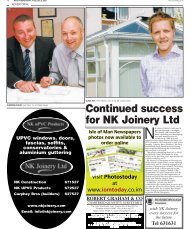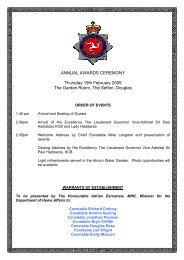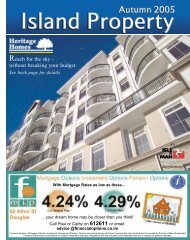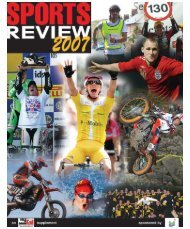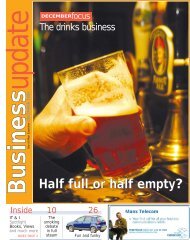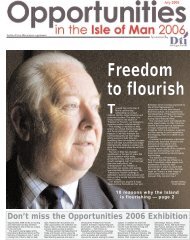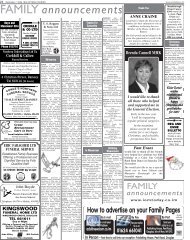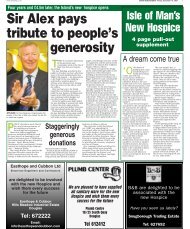m - Isle of Man Today
m - Isle of Man Today
m - Isle of Man Today
Create successful ePaper yourself
Turn your PDF publications into a flip-book with our unique Google optimized e-Paper software.
12<br />
m<br />
anxmillennium<br />
m<br />
anxmillennium<br />
13<br />
Another lantern slide given<br />
to the library (which was<br />
once dedicated to that<br />
great <strong>Man</strong>x historian, A. W.<br />
Moore) by Mr Craine in 1960. It<br />
has the title ‘Saltworks Pump<br />
House’. The location is the<br />
Point <strong>of</strong> Ayre and the small<br />
lighthouse which stands on the<br />
beach is just visible on the<br />
right hand edge. The <strong>Man</strong>x Salt<br />
and Alkali Company Ltd was<br />
formed in 1902 with a saltworks<br />
in Ramsey and a pipeline which<br />
brought the brine from an<br />
underground lake near the Point<br />
<strong>of</strong> Ayre. The saltworks were on<br />
the site <strong>of</strong> the shipyard at<br />
Ramsey. The buildings were<br />
taken over by the Harbour<br />
Board in 1956 and the two tall<br />
chimneys which were a feature<br />
<strong>of</strong> Ramsey for over 50 years<br />
were demolished in 1957. Despite<br />
the derelict state <strong>of</strong> this building<br />
it is interesting to note smoke<br />
coming out <strong>of</strong> the chimney.<br />
(MNH/pic/3602)<br />
The Douglas Head<br />
ferry but not one<br />
<strong>of</strong> those broad flat<br />
boats (The Rose,<br />
Thistle, Shamrock)<br />
which we tend to<br />
associate with the ferry<br />
that travelled from the<br />
Victoria Pier to the<br />
Battery Pier. The<br />
Lancashire Lass had<br />
started life as a steam<br />
tug but was altered to<br />
become a ferry boat.<br />
The empty boat<br />
alongside<br />
the<br />
breakwater is either the<br />
Jingo or Sambo which<br />
were owned by the Knox<br />
family <strong>of</strong> engineers (yes,<br />
Archie Knox’s father and<br />
brothers). The Knox’s<br />
were very clever<br />
engineers who had their<br />
own designs for many<br />
things to do with fishing<br />
boats and the likes. They<br />
also designed and made a<br />
change sorting and<br />
counting machine for use<br />
with the takings from the<br />
ferry. (MNH/pic/820)<br />
Another G. B. Cowen<br />
photograph which,<br />
according to the<br />
label on the side <strong>of</strong> the<br />
lantern slide, is taken at<br />
Ballaugh. The Cowen<br />
trademark <strong>of</strong> two girls on a<br />
bridge but not the usual<br />
fair <strong>Man</strong>x maids in their<br />
teens or twenties that he<br />
posed so <strong>of</strong>ten in his<br />
pictures. A collection <strong>of</strong><br />
conical haystacks in the<br />
field by the gate but<br />
whereabouts in Ballaugh is<br />
it? (MNH/pic/3535)<br />
Acase <strong>of</strong> early recycling for this view <strong>of</strong> the twin<br />
cars <strong>of</strong> the inclined railing <strong>of</strong> Port Soderick<br />
shows us what used to be the means <strong>of</strong> access to<br />
the Falcon Cliff Hotel and the adjoining pavilion. The<br />
complex was bought by the newly formed Palace and<br />
Derby Castle company but was closed down to<br />
concentrate business in those other two ventures. The<br />
pavilion was taken down (sorry I don’t know what<br />
happened to it) and the inclined railing which ran down<br />
from the eastern corner <strong>of</strong> the hotel to a castellated<br />
entrance between the hotels <strong>of</strong> Palace Terrace made its<br />
way to Port Soderick. Here it provided a link between the<br />
Southern Electric Railway and the refreshment rooms,<br />
hotel and amusements at the promenade level. The white<br />
painted wall on the left <strong>of</strong> the picture is still there today<br />
and it helps to identify the location <strong>of</strong> the railway. The<br />
advertisements are for the Victoria Cafe on the Victoria<br />
Pier; McCutcheons the grocers <strong>of</strong> Strand Street and for<br />
Clinch’s Ales. (MNH/pic/836)<br />
The road to Peel with Greeba Castle and<br />
Greeba Towers in the trees. The folktale is<br />
that the owner <strong>of</strong> Greeba Castle lost the<br />
property in a game <strong>of</strong> cards but built Greeba<br />
Towers in front <strong>of</strong> his former property to block the<br />
view <strong>of</strong> the new owner. There is truth in the fact that<br />
the owner <strong>of</strong> the castle did build the Towers and he<br />
did have money troubles as the coroner had<br />
arrested some <strong>of</strong> his property but the game <strong>of</strong> cards<br />
could be a case <strong>of</strong> folktale according to coach<br />
drivers. Greeba Castle was at one time used as a<br />
school but it is most famous for being the home <strong>of</strong> Hall<br />
Caine the Victorian author. He had at one time been in<br />
the <strong>of</strong>fice <strong>of</strong> an architect/builder in Liverpool and he<br />
redesigned the internal layout <strong>of</strong> the property as well<br />
as replacing the front door with a bay window, adding<br />
an Italian style piazza and turning a whole room into<br />
an entrance hall complete with bog oak beams and<br />
fittings. (MNH/pic/835)



